There are many soccer formations and it’s probably impossible to list them all, but in this part of the Soccer Training Guide I will present some of the most common that have been used in soccer, from Brazil World Cup winners to Nederland’s total soccer. Let’s start… A formation describes how the players in a soccer team are positioned on the field. Different formations may be used depending on the skill of your opponents but also if your team wants to play more attacking or defensive soccer. For example the 4-4-2, describes the formation of playing with 4 defenders, 4 midfielders and two forwards/strikers, and is the most widely used formation in soccer today.
A formation describes how the players in a soccer team are positioned on the field. Different formations may be used depending on the skill of your opponents but also if your team wants to play more attacking or defensive soccer. For example the 4-4-2, describes the formation of playing with 4 defenders, 4 midfielders and two forwards/strikers, and is the most widely used formation in soccer today.
There is no optimal soccer formation that your team can use for every match. Instead, the election will depend on how your opponents are playing. You may have heard that choice of a formation varies from one squad to another and that the best formation is the one which most suits your team. Well, this is true, but if you want to become good in soccer you must be able to play in all possible formations. Your team cannot either rely on one single formation; instead, the tactic must be adapted to the opponent’s. For example, let’s say that your opponents are playing 4-3-3. Then, your team may have to give up their standard formation (for ex: 3-4-3) because playing with only 3 defenders, especially against opponents with 3 forwards (for ex 4-3-3), will not bring good results if both your and the opposing team are on the same level.
Your team cannot either rely on one single formation; instead, the tactic must be adapted to the opponent’s. For example, let’s say that your opponents are playing 4-3-3. Then, your team may have to give up their standard formation (for ex: 3-4-3) because playing with only 3 defenders, especially against opponents with 3 forwards (for ex 4-3-3), will not bring good results if both your and the opposing team are on the same level.
A soccer formation can be altered during a soccer match, (if your team wants to defend or attack more) but it will require fast adaptations from you and your teammates. Some formations lend themselves to dynamically change during a match. The ultra offensive 4-3-3 formation can be switched to a more defensive 4-5-1 during a game. In a soccer formation the only unchangeable position is the soccer goalie. Regardless of your team’s formation choice, there must always be a goalkeeper. It is also the only player that has permission to grip the ball. This is a reason for why all formations seem to be based on 10 outfield players since the goalkeeper is seen as a compulsory player.
In a soccer formation the only unchangeable position is the soccer goalie. Regardless of your team’s formation choice, there must always be a goalkeeper. It is also the only player that has permission to grip the ball. This is a reason for why all formations seem to be based on 10 outfield players since the goalkeeper is seen as a compulsory player.
The Most Common Soccer Formations
The 4-4-2
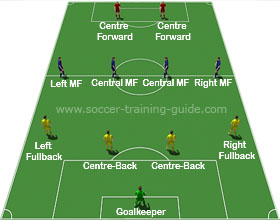 This is the most popular formation in soccer today. The main strength of the 4-4-2 formation is the balance. Offensive attacks are combined with solid defense. The weakness is the two center players who must be supported by the midfield.
This is the most popular formation in soccer today. The main strength of the 4-4-2 formation is the balance. Offensive attacks are combined with solid defense. The weakness is the two center players who must be supported by the midfield. The 4-3-3
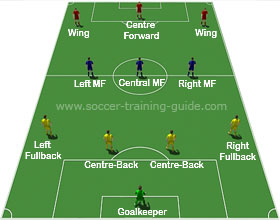 A classic formation that was adapted by the 1970's great teams. It was with the 4-3-3 that West Germany won the World Cup of 1974. This formation is typical for the total soccer system that was played by The Netherlands and West Germany. The mighty Barcelona of Spain has adapted this formation successfully in offense combined with good defense work.
A classic formation that was adapted by the 1970's great teams. It was with the 4-3-3 that West Germany won the World Cup of 1974. This formation is typical for the total soccer system that was played by The Netherlands and West Germany. The mighty Barcelona of Spain has adapted this formation successfully in offense combined with good defense work. The 3-4-3
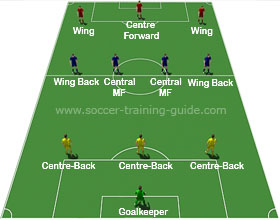 The 3-4-3 is an offensive formation with little defensive thinking. It is pretty unusual because all power is put in the offensive and you will not see many practicing it today.
The 3-4-3 is an offensive formation with little defensive thinking. It is pretty unusual because all power is put in the offensive and you will not see many practicing it today. The 3-6-1
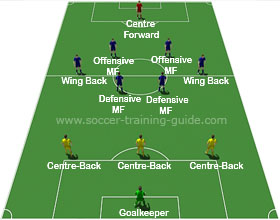 The 3-6-1 formation is often adapted by German teams. But, it can be catastrophic if the players are not prepared to put enough work in it. One example is the U.S national team that adapted it during the 98 World Cup and failed miserably.
The 3-6-1 formation is often adapted by German teams. But, it can be catastrophic if the players are not prepared to put enough work in it. One example is the U.S national team that adapted it during the 98 World Cup and failed miserably. The 3-4-2-1
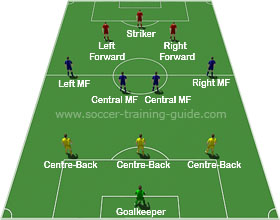 You will not see many teams playing with the 3-4-2-1 formation in today’s soccer. This formation is great when you want to put pressure on your opponents’ midfield. However, you will also need to put big effort in defense because your team will only have 3 defenders.
You will not see many teams playing with the 3-4-2-1 formation in today’s soccer. This formation is great when you want to put pressure on your opponents’ midfield. However, you will also need to put big effort in defense because your team will only have 3 defenders. The 4-5-1
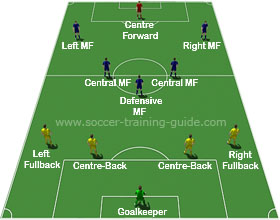 A formation with big defensive thinking that is usually adapted when you know the opposing team is the big favorite to win the match. It is criticized by many because it is so boring to watch; you should not expect any Brazil samba soccer when playing in this formation.
A formation with big defensive thinking that is usually adapted when you know the opposing team is the big favorite to win the match. It is criticized by many because it is so boring to watch; you should not expect any Brazil samba soccer when playing in this formation. The 5-2-2-1
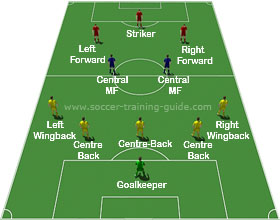 The 5-2-2-1 is a defensive form of the 3-4-2-1 formation. The formation has 5 defenders, 2 defensive midfielders, 2 offensive midfielders (that may also act as strikers) and one clean striker.
The 5-2-2-1 is a defensive form of the 3-4-2-1 formation. The formation has 5 defenders, 2 defensive midfielders, 2 offensive midfielders (that may also act as strikers) and one clean striker. The 4-3-3 Triangular Midfield
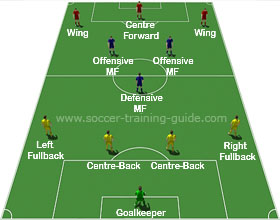 The 4-3-3 with a triangular midfield puts a holding central midfielder above the four defenders with two offensive midfielders behind the center forward and two wingers. The wingers are the workhorses of this formation as it flexes between a 4-3-3 on attack and 4-5-1 on defense.
The 4-3-3 with a triangular midfield puts a holding central midfielder above the four defenders with two offensive midfielders behind the center forward and two wingers. The wingers are the workhorses of this formation as it flexes between a 4-3-3 on attack and 4-5-1 on defense. The 3-5-2
The 3-5-2 is one of the modern formations in soccer today and is primarily associated with German soccer. The formation had it biggest popularity during the world cup in Italy (1990) where Germany won the whole competition. The system was also practiced successfully during the European Cup (1996) by Germans.

0 komentar:
Posting Komentar